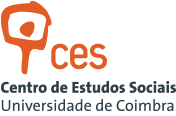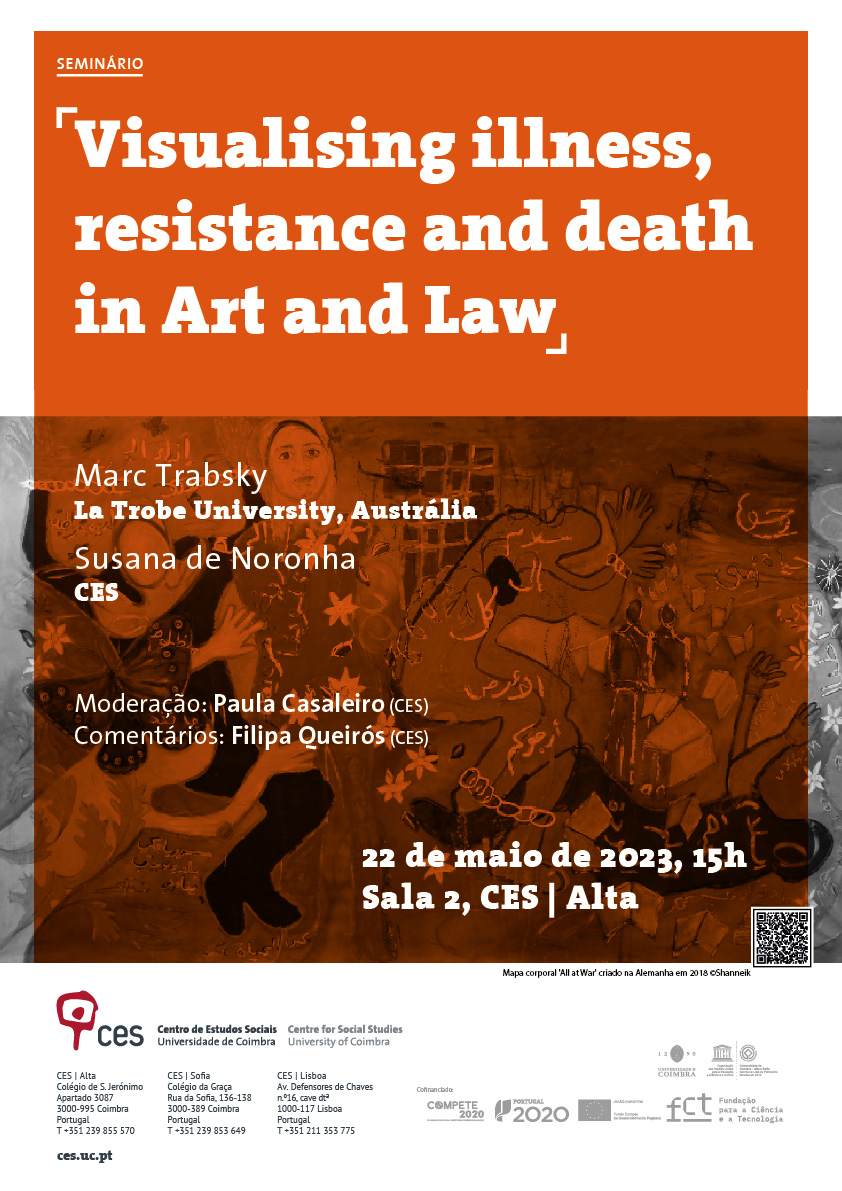Seminário
Visualising illness, resistance and death in Art and Law
Marc Trabsky
Susana de Noronha
22 de maio de 2023, 15h00
Sala 2, CES | Alta
Moderação: Paula Casaleiro (CES) | Comentários: Filipa Queirós (CES)
Apresentação
Neste seminário, Marc Trabsky e Susana de Noronha irão, através das suas comunicações, refletir, a partir de ângulos diversos mas convergentes, sobre as interseções entre direito e arte no que concerne representações sobre doença, resistência e morte.
Programa
Marc Trabsky (La Trobe University, Austrália): Forensic Imaginaries: Visualising the Corpse in Law
Resumo: Medico-legal investigations into sudden, unnatural, violent, and accidental deaths occupy an important role in legal systems. They require judicial observersto ascertain the identity of the deceased, determine the cause of a death and in many instances, make recommendations for reducing the occurrence of preventable deaths. In recent decades, the invasive autopsy has become a site of contestation during death investigations, especially for families of the deceased who oppose post-mortem dissections due to religious or cultural beliefs. Since the late twentieth century, forensic imaging technology, particularly post-mortem computed tomography (CT), has offered the ideal of avirtual autopsy. However, little is known about how technological modifications to medico-legal investigations assist or hinder practitioners in fulfilling their responsibilities under the law. This paper will critically examine how forensic imaging technology has transformed the way legal institutions visualise the corpse in the twenty-first century.
Forensic imaging technology has demanded that coroners, pathologists, prosecutors, and lawyers acquire new skills in deciphering the meaning of pixelated shadows andinterpreting CT scans as evidence of death causation. It has also problematised the ‘mechanical objectivity’ of the forensic gaze by embedding an optical device between the dead body, the medico-legal expert, and the judicial observer. CT comprises both a mechanical instrument and a computational technique that virtualises the interiority of the corpse by slicing it into sections without opening it up. It obfuscates the epistemological boundaries between unique identifiers of a tomographic corpse, its representation as an undefined set of slices that could belong to any-body, and its abstraction in three-dimensional visualisations of data. In transmogrifying the materiality of organs, tissues and bones into multi-planar reconstructions, the technology offersjudicial observers the allure ofseeing ‘corporeal evidence’ with their own eyes. This paper argues that forensic imaging technology makes demands on legal institutions to question the truth of what they see and acknowledge the limits of their capacity to know the corpse.
Susana de Noronha (CES): The art and material culture of cancer: extending existence beyond skin and death
Resumo: Merging three subfields – the anthropology of art and material culture, medical anthropology, and science and technology studies – my interlocutors are female cancer patients and survivors, focusing on their standpoints, situated knowledge and creative agency. This presentation unfolds the results of a research trilogy about artistic representations of illness, resistance, and death. (Part I) While analysing artistic projects created by (or with) women with breast cancer, what does the embodied knowledge of cancer patients teach us and what can their artistic narratives accomplish? Art will be understood as a constitutive part of experience itself, a form of knowledge and transformative action, immersed on the way patients live, understand and cope with breast cancer, between individual expression and collective activism, between remission and terminal experiences. (Part II) Opening my research to all other organs affected by malignancies, but also to women’s representations of biomedical material culture, what can you know about cancer by looking at the uses and meanings given by women artists to these objects? What kind of stories can you tell, by focusing on a series of objects – on the material culture of cancer? Objects will be understood as modular components of our cancer experiences, inseparable from our bodies, defending the idea of a “third half” that unites everything and everyone, across life and beyond death. (Part III) From theory to practice, bringing scientific illustration into my research work, I transferred to paper the stories of eight women and cancer patients from my relational circle, completing the texts with drawings, paintings, and photographs, aiming to change our collective imagery and understandings about health andillness. This collaborative research blends embodied knowledge, oral narrative, anthropological reasoning, and art, reinventing social scienceand ethnographic drawing, enhancing them with metaphor and imagination. These three investigations point to the outline of another ontology, epistemology and methodology, a “third half” where people, experiences, objects and different forms of knowledge are parts of an undivided and indivisible sum, extending existence beyond skin and death.
Notas biográficas
Marc Trabsky | Associate Professor in Law, and an Australian Research Council DECRA Fellow on ‘Socio-Legal Implications of Virtual Autopsies in Coronial Investigations’ (DE220100064) at La Trobe University, Melbourne, Australia. He has written Law and the Dead: Technology, Relations and Institutions (Routledge, 2019), which was awarded the Law and Society Association of Australia and New Zealand Book Prize in 2019, and Death: New Trajectories in Law (Routledge, 2023, forthcoming). He is also co-editing with Imogen Jones the Routledge Handbook of Law and Death (Routledge, 2024, forthcoming). Marc will be a Liberty Fellow of the School of Law, University of Leeds, in 2023.
Susana de Noronha | Anthropologist, PhD in Sociology, is Researcher at the Centre for Social Studies (CES), University of Coimbra, Portugal. Elected Secretary of CES General Assembly, Co-coordinator of CES Ethics in Research Discussion Group, and member of the Editorial Board of the CES Collection Book Series (U. Coimbra Press IUC). Invited Assistant Professor and Member of the Coordinating Committee of the Department of Sociology, University of Minho, Portugal. ASDS Ambassador for Portugal (The Association for the Study of Death and Society, UK). Between 2020 and 01/2022, she was Co-coordinator of the Science, Economy and Society Research Group (NECES) and Member of the Standing Committee of CES Scientific Board. Distinguished by an international jury with the 2007 CES Award for Young Portuguese-speaking Social Scientists and winner of the 2003 Bernardino Machado Award for Anthropology, by the University of Coimbra. Single authorofthe research monographsA tinta, a mariposa e a metástase: a arte como experiência, conhecimento e acção sobre o cancro de mama (2009, Afrontamento); Objetos feitos de cancro: mulheres, cultura material e doença nas estórias da arte (2015, Almedina); andCancro sobre papel: estórias de oito mulheres portuguesas entre palavra falada, arte e ciência escrita (2019, Almedina). As a writer and researcher, she is also a published lyricist and author of scientific illustrations, using photography, painting and creative ethnographic drawing.


